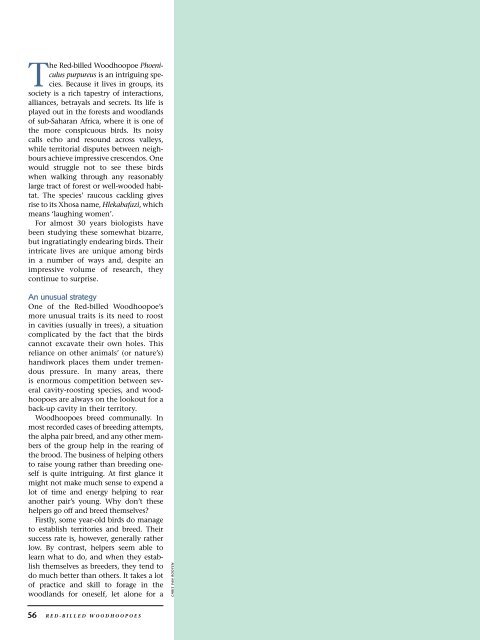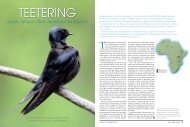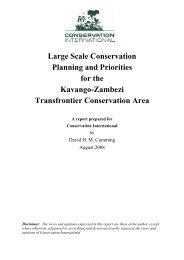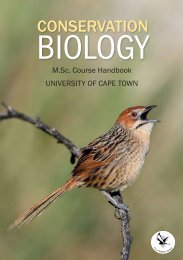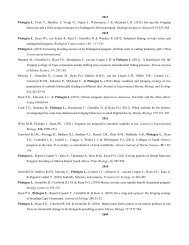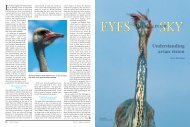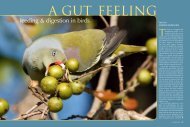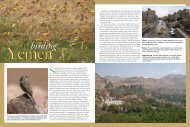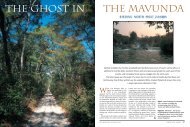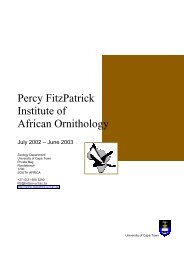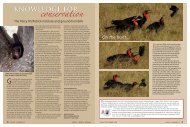Preening power: red-billed woodhoopoes go on the defensive
Preening power: red-billed woodhoopoes go on the defensive
Preening power: red-billed woodhoopoes go on the defensive
- No tags were found...
Create successful ePaper yourself
Turn your PDF publications into a flip-book with our unique Google optimized e-Paper software.
The Red-<str<strong>on</strong>g>billed</str<strong>on</strong>g> Woodhoopoe Phoeniculuspurpureus is an intriguing species.Because it lives in groups, itssociety is a rich tapestry of inter acti<strong>on</strong>s,alliances, betrayals and secrets. Its life isplayed out in <strong>the</strong> forests and woodlandsof sub-Saharan Africa, where it is <strong>on</strong>e of<strong>the</strong> more c<strong>on</strong>spicuous birds. Its noisycalls echo and resound across valleys,while territorial disputes between neighboursachieve impressive crescendos. Onewould struggle not to see <strong>the</strong>se birdswhen walking through any reas<strong>on</strong>ablylarge tract of forest or well-wooded habitat.The species’ raucous cackling givesrise to its Xhosa name, Hlekabafazi, whichmeans ‘laughing women’.For almost 30 years biologists havebeen studying <strong>the</strong>se somewhat bizarre,but ingratiatingly endearing birds. Theirintricate lives are unique am<strong>on</strong>g birdsin a number of ways and, despite animpressive volume of research, <strong>the</strong>yc<strong>on</strong>tinue to surprise.An unusual strategyOne of <strong>the</strong> Red-<str<strong>on</strong>g>billed</str<strong>on</strong>g> Woodhoopoe’smore unusual traits is its need to roostin cavities (usually in trees), a situati<strong>on</strong>complicated by <strong>the</strong> fact that <strong>the</strong> birdscannot excavate <strong>the</strong>ir own holes. Thisreliance <strong>on</strong> o<strong>the</strong>r animals’ (or nature’s)handiwork places <strong>the</strong>m under tremendouspressure. In many areas, <strong>the</strong>reis enormous competiti<strong>on</strong> between severalcavity-roosting species, and <str<strong>on</strong>g>woodhoopoes</str<strong>on</strong>g>are always <strong>on</strong> <strong>the</strong> lookout for aback-up cavity in <strong>the</strong>ir territory.Woodhoopoes breed communally. Inmost recorded cases of breeding attempts,<strong>the</strong> alpha pair breed, and any o<strong>the</strong>r membersof <strong>the</strong> group help in <strong>the</strong> rearing of<strong>the</strong> brood. The business of helping o<strong>the</strong>rsto raise young ra<strong>the</strong>r than breeding <strong>on</strong>eselfis quite intriguing. At first glance itmight not make much sense to expend alot of time and energy helping to rearano<strong>the</strong>r pair’s young. Why d<strong>on</strong>’t <strong>the</strong>sehelpers <str<strong>on</strong>g>go</str<strong>on</strong>g> off and breed <strong>the</strong>mselves?Firstly, some year-old birds do manageto establish territories and breed. Theirsuccess rate is, however, generally ra<strong>the</strong>rlow. By c<strong>on</strong>trast, helpers seem able tolearn what to do, and when <strong>the</strong>y establish<strong>the</strong>mselves as breeders, <strong>the</strong>y tend todo much better than o<strong>the</strong>rs. It takes a lotof practice and skill to forage in <strong>the</strong>woodlands for <strong>on</strong>eself, let al<strong>on</strong>e for aChris van rooyenLeft and right Communalliving has advantages for <strong>the</strong><str<strong>on</strong>g>woodhoopoes</str<strong>on</strong>g> – increased numbersmean a better defence systemand more helpers to feed<strong>the</strong> young.brood of highly demanding, growingchicks. A sec<strong>on</strong>d reas<strong>on</strong> is that moreoften than not, helpers are ‘family’; ei<strong>the</strong>roffspring from earlier breeding attemptsor related (typically siblings) to <strong>on</strong>e of <strong>the</strong>alpha pair. It makes biological sense toinvest in <strong>on</strong>e’s family, even if <strong>the</strong> youngbeing ca<str<strong>on</strong>g>red</str<strong>on</strong>g> for aren’t <strong>on</strong>e’s own. Becauseof this ‘blood c<strong>on</strong>necti<strong>on</strong>’ or relatedness,helpers invest <strong>the</strong>ir efforts in ensuringthat <strong>the</strong>ir sha<str<strong>on</strong>g>red</str<strong>on</strong>g> genes are passed <strong>on</strong> to<strong>the</strong> next generati<strong>on</strong>. This co-operativebreeding strategy is employed by a diversityof animals, ranging from h<strong>on</strong>ey-beesand ants to naked mole-rats.A third reas<strong>on</strong> is that in some circumstancesroosting cavities and territoriesare hard to come by, and even harder todefend. A larger group can usually defenda cavity or maintain a large territory, andwhen times are tough, for example intimes of drought, territories are oftenexpanded to improve foraging. Under<strong>the</strong>se circumstances, small groups run<strong>the</strong> risk of being displaced completely.This can be an utter disaster for <str<strong>on</strong>g>woodhoopoes</str<strong>on</strong>g>,which have to find safe roostingcavities every night. It seems that<strong>the</strong> best opti<strong>on</strong>, unless ano<strong>the</strong>r territorycan be found immediately, is to joinano<strong>the</strong>r group.The disadvantage of joining ano<strong>the</strong>rgroup is that newcomers always start at<strong>the</strong> bottom of <strong>the</strong> ladder. A very str<strong>on</strong>gpecking order is present in most grouplivingbirds and in <str<strong>on</strong>g>woodhoopoes</str<strong>on</strong>g> thistakes <strong>on</strong> added significance. Should <strong>on</strong>eof <strong>the</strong> alpha pair die, <strong>the</strong> male or femalenext in line in <strong>the</strong> pecking order willtake over as breeders. For newcomersthis can mean a very l<strong>on</strong>g wait for <strong>the</strong>chance to reproduce.Threats from p<str<strong>on</strong>g>red</str<strong>on</strong>g>atorsNo <strong>on</strong>e is really too sure why <str<strong>on</strong>g>woodhoopoes</str<strong>on</strong>g>always roost in a cavity. Some evidencesuggests that during winter, grouphuddling in cavities can result in a c<strong>on</strong>siderablesaving of energy. This does notexplain why, <strong>on</strong> warm nights, cavi- Brendan Ryan56 <str<strong>on</strong>g>red</str<strong>on</strong>g>-<str<strong>on</strong>g>billed</str<strong>on</strong>g> WoodHoopoesfebruary/march 2001<str<strong>on</strong>g>red</str<strong>on</strong>g>-<str<strong>on</strong>g>billed</str<strong>on</strong>g> WoodHoopoes57


